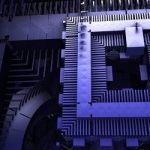Cornell Researchers Develop Algorithm to Apply to Quantum Materials & Techniques that May Apply to Quantum Computing

(ScienceDaily) A Cornell collaboration led by physicist Brad Ramshaw, the Dick & Dale Reis Johnson Assistant Professor in the College of Arts and Sciences, used a combination of ultrasound and machine learning to narrow the possible explanations for what happens to quantum material uranium ruthenium silicide (URu2Si2) when it enters a so-called “hidden order.” Extreme temperature can do strange things to metals. In severe heat, iron ceases to be magnetic. In devastating cold, lead becomes a superconductor.
“In uranium ruthenium silicide, we have no idea what the electrons are doing in the hidden order state,” said Ramshaw, the paper’s senior author. “We know that they don’t become magnetic, we know that they don’t become superconducting, but what are they doing? There are a lot of possibilities — orbital order, charge density waves, valence transitions — but it’s hard to tell these different states of matter apart. So the electrons are ‘hiding,’ in that sense.”
The team’s algorithm can be applied to other quantum materials and techniques, most notably nuclear magnetic resonance (NMR) spectroscopy, the fundamental process behind magnetic resonance imaging (MRI). Ramshaw also plans to use the new technique to tackle the unruly geometries of uranium telluride, a potential topological superconductor that could be a platform for quantum computing.





















